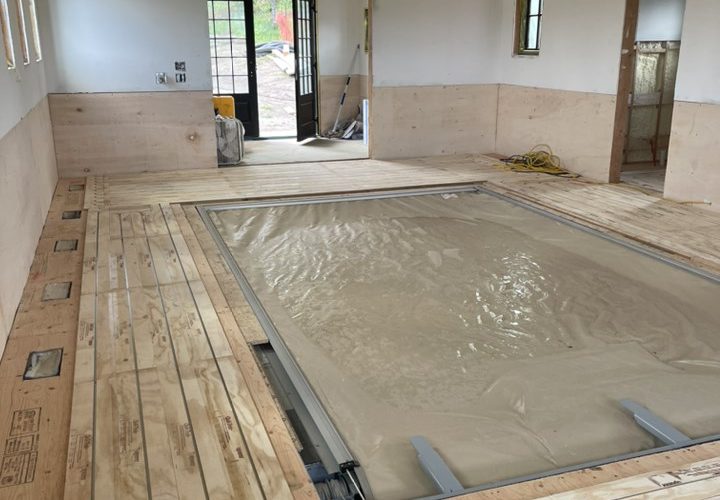
Installing Radiant Heated Floors in your Home
Radiant heated floors are energy-efficient, cost-effective, and will keep you warm and comfy throughout the cold seasons. Rather than having forced heat being pushed out from a ventilation system that heats up the air, the heat is being supplied by hot-water tubes or electric wires buried underneath the floor. The warm air will evenly heat up the floor and any object in the room as it rises to allow the coolest air to stay near the ceiling whereas, with forced air, the heat will quickly rise to the ceiling and then cool down as it falls back to the floor.
Types of Radiant Heat:
When considering installing radiant heated floors know that there are two different types of systems that can be installed: electric and hydronic.
- Electric systems require electricity to be passed through a network of cables to heat up the floor. While this may save you on heating costs, it would be very expensive on your electricity bill if you were to try and use an electric system to heat up your entire home.
- A hydronic system uses a boiler to heat up water and send it through the tubing underneath your floors. Hydronic systems are recommended if trying to heat up a large area or your entire home.
The Pros of Having Radiant Heated Floors:
Efficiency:
As stated, the heat has less of a distance to travel so it will require less effort to heat up a room than regular forced air systems. Less effort will need to be put into warming up the room and since it is directly heating the floor and spreading from there, it does not need to be at such a high temperature to feel its effects. Along with that, all systems are connected to a thermostat for easy control of temperatures.
More Space:
Regular radiators are typically on the walls or ceilings, which can sometimes cause issues with the layout or the overall aesthetic of your room. With floor heat, there is no need to worry about that.
Uniform Heating:
Since the tubes are spread out across the entire floor this will help prevent any potential cold spots. With forced air, the warmer parts of the room are usually located near the vents.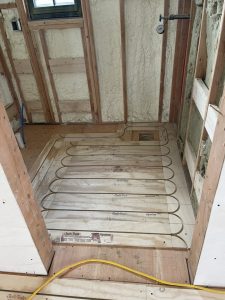
Lifespan:
Heated floors, if installed with proper care and quality equipment, can last adequately for 10-20 years. This is assuming there is no major damage such as flooding or any errors when it comes to installation. These floors usually do not require much maintenance and are usually supplied with a lengthy warranty to provide you peace of mind.
Quite and Clean:
Radiant heated floors do not have blowers rushing air through them so they are completely silent. With forced air, most people have simply become accustomed to listening to their heat blow out through the vents and that can often be a noisy disturbance. Since there is no air blowing, this also ensures no dust or germs are flying through the air which can be a life-changer for those with allergies.
Things to Consider:
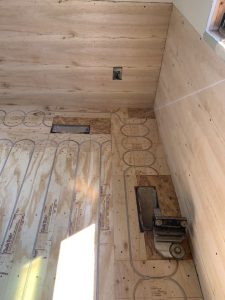
Cooling systems:
While radiant heated floors are great, they do not provide fresh air. Therefore, you will still need some sort of ventilation system to remove the humidity and bring in the fresh air. In addition, if you require air conditioning during the warmer months it will have to be installed separately. If you are just heating/cooling one room this may be manageable as you can purchase an AC unit for that one specific room. However, if it is a large space, you may need an entire AC system installed.
Cost of installation:
Depending on the size of the project, installation can be quite expensive. Hydronic or water-based radiant heated flooring costs between $6 to $20per square feet. Electric-based radiant floor heating runs between $8 to $15 per square foot (Forbes). Consider it an investment as you will eventually see an ROI in the savings you make in lowering the heating costs, as radiant heated floors require a lower temperature to heat up a room.
Install Time:
The water-based heating system will usually take longer to install. Install time depends on when you are doing the project. If you are in the process of a remodel or new build, it would be the perfect time to install them. If the current floors need to be taken up, install time will take longer.
Increase the height of your floor:
this may not be a large concern for many, however, it should be mentioned. Installing under-floor heating will increase the floor height in the room by around ½ inch; depending on the system you choose.
Final Thoughts
If you are tired of walking on cold floors or enduring cold spots in your home, radiant floors will provide just the comfort you are looking for. If you are considering radiant floors for any part of your home, It is best to do them either while the home is being built or remodeled. Otherwise, you would have to take up the entire floor. Which can be a lengthy and costly process.
Radiant heated floors may not be the right choice for every home. Even though this is a more efficient way of heating up your home, some homes may require another heat source. It will vary depending on your home and the type of project you are taking on. Both electric and hydronic have their benefits and can be a great way to heat up your home.
Check out more pictures of our latest radiant heat install in a pool barn.
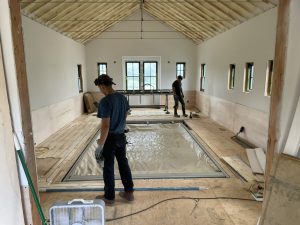
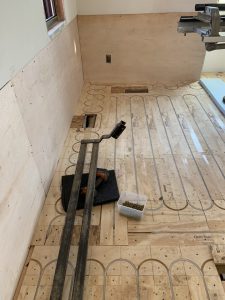
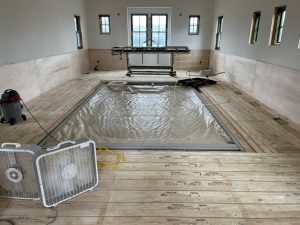
Questions about installation of radiant heated floors? Contact us!




